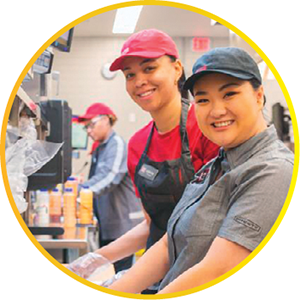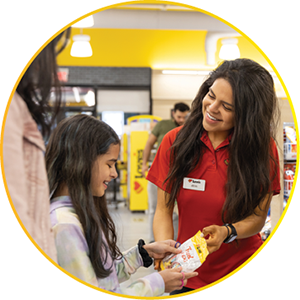Although company culture has been a hot topic in the HR space for quite some time, what often gets overlooked in customer-facing industries is the correlation between employee happiness and engagement and increased customer loyalty. According to Sheetz President and CEO Travis Sheetz, Sheetz stores where employees are more engaged without question have better sales metrics. “If people aren’t happy to be there, that naturally reaches across the counter,” said Sheetz during a panel discussion at the 2021 NACS Show.
 Sheetz Associates at work in the kitchen.
Sheetz Associates at work in the kitchen.
Jenny Love Meyer, chief culture officer at Love’s Travel Stops and also a 2021 NACS Show presenter, said culture is vital for employee engagement, and many times it’s not about the paycheck for employees. It’s about what values your employees can gain by working at your store. “[Culture] is akin to the water at the aquarium. It’s always there and almost see-through, but it has to be nourished to keep the fish and others alive and thriving,” she said.
Minnesota-based 36 Lyn Refuel Station cultivates a culture where employees feel dignified and respected in their positions. “We had a shirt made that our staff loves to wear that says, ‘The whole world is short staffed right now. Be kind to those who showed up.’ A lot of customers really love the shirt because it’s acknowledging those that are getting up each day and going to work whether they be trauma surgeons, fire women or front-line employees like a lot of my staff,” said Lonnie McQuirter, owner and director of operations.
Our staff t-shirt says ‘The whole world is short staffed right now. Be kind to those who showed up.’
That internal respect for employees is then reflected outward to customers. McQuirter says the c-store prides itself on knowing its customers and being a place where people from different walks of life can feel comfortable shopping any time of the day. “How [a customer] starts the day or how they finish the day can really make their week, their month or their year if they had a good experience at a convenience store or any other place they stop in,” said McQuirter.
DEFINING LOYALTY
36 Lyn is a one-location convenience store located in downtown Minneapolis. McQuirter says that to increase customer loyalty, it’s important to determine what loyalty means for your company. He says that loyalty shouldn’t be defined just by repeat customers. Over the past year, one of 36 Lyn’s goals was to spend more time with customers and engage with them longer.
“It’s really about engaging and spending time talking with customers longer because in our city and what’s been going on the past couple years, there are a lot of people that are struggling to find a sense of community and a place where they belong,” said McQuirter.
 36 Lyn team members sport their staff t-shirts.
36 Lyn team members sport their staff t-shirts.
McQuirter empowers his employees to engage with customers with that goal in mind—to make people feel welcome and that they belong. Having this unified, altruistic goal shows employees that what they do matters, he says. McQuirter believes his employees’ greater purpose is to create a culture of belonging for the community—which in turn, creates that same culture for the employees. “Defining [your] goals and really working with the staff by talking about them is something that’s really important,” said McQuirter.
MEASURING SUCCESS
“The true measure of a store’s culture is what goes on when you’re not there,” said Sheetz. When he first started working at the company, the culture was good, but nothing was formalized. Sheetz and his team identified seven key culture points, putting respect at the center, and then they tested it against organization. “It has to feel right to the employees of the company. Before that, it was a feel when you worked at Sheetz. When we formalized it, we created an expectation and a means to measure it,” said Sheetz.
Headquarters sends culture surveys to each store—one focused on the store and another on the store manager. The retailer also participates in Fortune Magazine’s Best Companies to Work For list, but the primary goal is not to have the Sheetz name on the list but to receive the information on other often-competing companies on the list.
“We are very purposeful about managing culture. We take all employee complaints to a specific employee engagement group in the company. The group looks at the results and uses culture scores from the results to develop [employees]. Sheetz doesn’t fire over [the results]. It’s a way to coach them,” said Sheetz.
Another way company culture engages employees is by taking care of the mental and emotional wellbeing of their employees. “We make sure that work is not dominating their life—there’s a different work expectation now,” said Sheetz.
Love’s, based in Oklahoma City, Oklahoma, assesses employee engagement through a variety of measures, including an annual employee survey with the same questions year over year to establish benchmarks. The company also looks at employee turnover and retention. For Love’s, another sure sign of good culture at a store is the number of referral bonuses a store receives.
 A Love’s Travel Stops associate talks to a young customer
A Love’s Travel Stops associate talks to a young customer
36 Lyn gauges employee engagement a little differently. McQuirter picks up anecdotes from customers when he’s in the store, and he pays attention to customer reviews. McQuirter also takes the time to sit down and ask staff members how they think the store has been doing and how customer interactions are going, and he asks them to identify the weaknesses and strengths of the culture.
“Those are questions that we ask on a regular basis of the staff. It helps to align us so that the goals that I have and the goals that they have are one in the same,” said McQuirter. He also asks each staff member who has been invaluable to them recently, whether it be a co-worker, customer, family member—anyone.
McQuirter also asks them another question: What else? “[Both of these questions] are to help stimulate them and allow them to say whatever’s on their mind. It helps them identify their feelings and opinions or why they may or may not be happy,” he explained.
McQuirter recently spoke with an employee and the conversation turned into a six-hour talk, with McQuirter mainly listening. Later, he heard that the employee shared with co-workers that the conversation with McQuirter had left an impression and that no one had given them the opportunity to talk like that before.
“Part of my aim is for me to understand [my employees] and to help [my employees] understand the person on the other side of the counter,” he said.
MAKING TIME
Companies that want to start working on their culture should begin by writing down what a good employee culture means to their company uniquely, says Sheetz. “Write it down so you know how to hire to it and lead to it. ... It’s never too late. It’s a marathon not a sprint,” said Sheetz.
Love Meyer agreed and added, get to know your organization by surveying employees to see why they stay at your organization—that in turn becomes the basis of your organization, she says.
But for small operators, focusing on employee culture as it relates to customer loyalty can seem like a time expense they may not be able to afford. McQuirter, whose store has 10 employees, says looking at it from that perspective misses the point of what loyalty is about. “People kind of have this jealousy toward large companies with their huge teams [dedicated] to loyalty, and they’re kind of missing a big point here,” said McQuirter.
The people “helping them get to where they need to be are their staff and their customers,” he said. They are the “more sophisticated parts of our business operations,” McQuirter said.